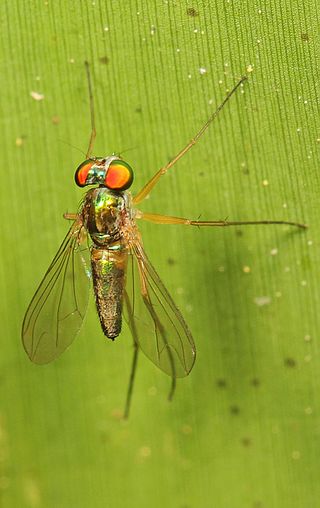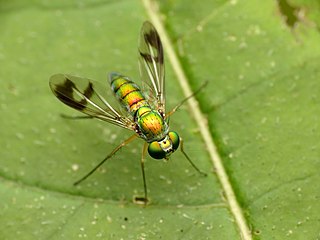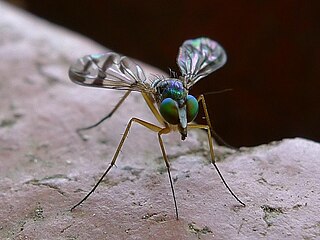Abbemyia is a genus of flies in the family Dolichopodidae, known from Australia and New Caledonia. It is named after the French entomologist Abbé Octave Parent, who studied the family Dolichopodidae.

Amblypsilopus is a genus of flies in the family Dolichopodidae. It is a large genus, with about 350 species recorded. However, it is possibly polyphyletic.

Austrosciapus is a genus of flies in the family Dolichopodidae. It is mainly found in Australia, though some species are also known from New Zealand, French Polynesia, Norfolk Island and the Hawaiian Islands.

Chrysosoma is a genus of flies in the family Dolichopodidae. It is a large genus, with more than 200 species distributed in the Old World and Oceania.

Condylostylus is a genus of flies in the family Dolichopodidae. It is the second largest genus in the subfamily Sciapodinae, with more than 250 species included. It has a high diversity in the Neotropical realm, where 70% of the species occur.
Dytomyia is a genus of flies in the family Dolichopodidae. It is known from Australia, Madagascar and Kenya, with an undescribed species from Papua New Guinea.
Ethiosciapus is a genus of flies in the family Dolichopodidae.
Helixocerus is a genus of flies in the family Dolichopodidae. It is known from New Caledonia, American Samoa and Western Samoa.

Heteropsilopus is a genus of flies in the family Dolichopodidae. The genus comprises large-sized sciapodines mostly with a strongly sinuate m-cu and simple digitiform cercus. The strongly sinuate m-cu is considered to be a distinctive group autapomorphy.
Mascaromyia is a genus of flies in the family Dolichopodidae, endemic to the western Indian Ocean islands. It is named after the main distribution of the genus, the islands of the submarine Mascarene Plateau, combining it with "myia".
Mesorhaga is a genus of flies in the family Dolichopodidae.
Narrabeenia is a genus of flies in the family Dolichopodidae, living in Australia and named for Narrabeen, New South Wales.

Naufraga hexachaeta is a species of fly in the family Dolichopodidae. It is the only member of the genus Naufraga, and is found only in the South Island of New Zealand.
Plagiozopelma is a genus of flies in the family Dolichopodidae.

Sciapodinae is a subfamily of flies in the family Dolichopodidae. Members of the subfamily possess several ancestral characteristics of the family, such as branched vein M1+2 in the wings (though M2 is absent or reduced in Mesorhagini) and a pedunculate hypopygium. They also typically have a deeply excavated vertex, giving their heads the appearance of a dumbbell when viewed from the front.

Diaphorinae is a subfamily of flies in the family Dolichopodidae.

Sympycninae is a subfamily of flies in the family Dolichopodidae. In some classifications, this subfamily includes the genera of the subfamilies Peloropeodinae and Xanthochlorinae.

Sciapodini is a tribe of flies in the family Dolichopodidae.

Chrysosomatini is a tribe of flies in the family Dolichopodidae.









